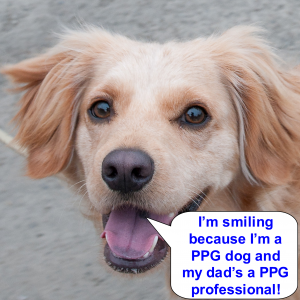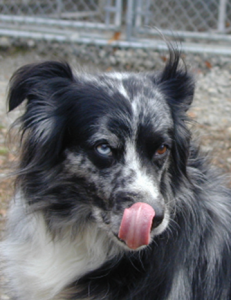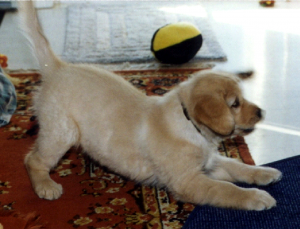< Updated 5DEC18 >
< http://bit.ly/Dominance-RealityorMyth >
Listen to a podcast on this topic that first aired on The Woof Meow Show on March 21st, 2010 by clicking here
It was in the September of 2002 that the first version of this article appeared in Paw Prints, the Green Acres Kennel Shop newsletter. I update the article on a regular basis because sadly there are still too many people, some of them animal professionals, and some who try to play the part on TV, promulgating the dominance myth. Unfortunately a popular reality TV show has captured people’s attention and is talking about dogs as pack animals and again perpetuating the idea of using “calm-assertive energy” (read: fear and intimidation) to resolve issues with problem dogs. Like most “reality” TV shows there is very little that is real here. The methods and approach used on this show are contraindicated by science and behavioral experts and many consider them inhumane. Unfortunately, many viewers do not seem to understand that the show is edited but instead believe “miracles happen in 30 minutes.” Even though each show contains a disclaimer; “please do not attempt any of these techniques on your own, consult with a professional,” people do try these techniques at home and cause further harm to dogs that are already suffering. As result the two largest organizations of professionals that deal with animal behavior; the American Veterinary Society of Animal Behavior (AVSAB) and the Association of Pet Dog Trainers (APDT) have issued official positions warning against the use of the dominance approach in training or dealing with behavioral issues with dogs. In 2010 Green Acres elected to do the same in an effort to educate dog lovers about our position on this topic. That position statement can be found on our blog at http://bit.ly/GAKS-Pos-NoPain-NoForceNoFear.
If you attended a dog training class anytime through the 1990’s, if you read any dog training books written during this period, or if you have had any behavioral issues with your dog, then you have most likely heard about dominance. You were probably told that in order to prevent your dog from becoming dominant that you had to do one or more of the following things:
- Always go through doorways first,
- Always eat before your dog,
- Never allow the dog on furniture where they might be elevated above you,
- Never allow the dog to sleep on your bed,
- Always punish your dog for stealing or chewing things that belong to you,
- Push your dog away when they jump up or paw at you, and
- Never let your dog pull on leash.
Essentially you were advised to be ever vigilant and to show your dog that you were the boss in order to prevent him from taking over your home and becoming disobedient and even possibly aggressive.
The Myth
The concept of the dominant dog was based on an experimental model of how wolves interact socially within a group. The wolves being studied were described as having a strict, force-based hierarchical structure where one male and one female were always the dominant ones, also known as the alpha pair. These dominant wolves had first access to the resources necessary for survival: food, water, and a mate, and fought to maintain these resources. The other wolves in the pack were constantly challenging the alphas so that they could take their positions and have first access to the resources. Someone then extrapolated that since wolves and dogs are biologically the same species, dogs must also be struggling for dominance amongst each other and with us.
This myth that dogs were striving to be the alphas over us led to the philosophy that we must always maintain dominance over our dogs and that the best way to do that is to use physical and mental intimidation, just like the captive wolves used with each other. This philosophy was pushed in a popular book of the 1970’s, How to Be Your Dog’s Best Friend, by the Monks of New Skete. The Monks included detailed instructions for physically disciplining your dog. They recommended hitting your dog hard enough under the chin so that it hurts and shaking the dog by the scruff of their neck while yelling at them. The Monks described something they called the alpha wolf rollover as the ultimate punishment for the most severe disobedience. This involves grabbing the dog by the scruff of their neck, and firmly and rapidly rolling the dog on its back and pinning it while making eye contact and yelling at the dog. In their book the Monks asserted that these disciplinary techniques are what a mother wolf would use in the wild to discipline her pups.
The fact is the Monks had no idea what they were talking about, and some of them have since recanted this particular method of punishment, as the “alpha wolf rollover” does not happen with wolves. The Monks of New Skete were not alone in their flawed understanding of canine behavior. The concept of dominance and putting the dog in its place was, and in some cases still is, very pervasive in the field of dog training.
My first personal experience with the alpha wolf rollover occurred in 1991 at the very first dog training class that I attended. Based on the recommendation of our veterinarian, Paula and I were taking our 12 week old Cairn Terrier puppy, Gus, to an obedience class. It was the first night of class and all of the puppies were expected to sit on command. When Gus would not sit, the instructor told me I had to show him who was boss and make him sit, and if he still wouldn’t do it, then I should alpha roll him. Well Gus wouldn’t sit (I know now he had no clue what I was even asking for) and so I was told to “alpha roll him!” I soon had a terrified (unknown to or disregarded by everyone) puppy, flat on his back, pinned to the floor, eyes rolling, body writhing, mouth growling and snapping at everything. The instructor was really adamant now: “We can’t have that! Grab his muzzle and clamp it shut!” My instincts said “Whoa! That’s not safe!” but these people were the “experts” so I grabbed Gus’ muzzle in my hand. Instantly, I felt his canines puncture my palm. As my blood started dripping on the floor, Gus broke free and moved as far away from me as he could. There is something to be said for listening to your gut instincts. Gus listened to his; I failed to listen to mine. Unbeknownst to me at the time, everything that I had read and been taught about the alpha wolf rollover was based upon flawed knowledge. My puppy was afraid for his life and it was my fault.
The “alpha wolf rollover” or other methods of physical punishment have no place in dog training. They are:
- Dangerous and a great way to give your dog a good reason to bite you.
- Damaging to the relationship between pet parent and dog. It teaches them to mistrust you.
- A great way to make a good dog aggressive – aggression by the pet parent will result in escalated aggression by the dog.
Patricia McConnell, Ph.D. describes these methods in her book, The Other End of the Leash – Why We Do What We Do Around Dogs: “So much old-fashioned obedience training could be summarized as, Do it because I told you to and if you don’t, I’ll hurt you.”
As for Gus and me, I do not really remember much of what happened next other than being offered ice for my hand as Paula worked with Gus for the remainder of the class. In fact, Gus and I were rather wary of each other for quite some time and I let Paula take him to the rest of his classes for the next year. Over time and lots of games of tennis ball, Gus and I learned to trust one another again and started having fun. As I started to learn more about dogs I discovered that there were far better ways to train a dog than with fear and intimidation and trying to be dominant.
The Reality
The wolves being studied that resulted in the conception of the dominance construct were not a pack of wolves living in the wild but were in fact a mixed non-familial group of wolves living in a fenced enclosure, some as small as 5 acres, with far less resources than what would be available in the wild. This was not a normal family of wolves nor were these wolves in a typical environment. They were forced to live under extremely stressful and unnatural conditions. Is it any wonder they became aggressive?
We now know that true wolf packs, living in the wild, do NOT have a strict, force-based hierarchical structure. In Alpha Status, Dominance, and Division of Labor in Wolf Packs, biologist L. D. Mech notes “… in natural wolf packs, the alpha male or female are merely the breeding animals, the parents of the pack, and dominance contests with other wolves are rare, if they exist at all. During my 13 summers observing the Ellesmere Island pack, I saw none.” What Mech observed was a family of wolves: a breeding pair, pups and possibly some of last year’s pups. The breeding pair provides for and raises the young until such time that they move on to start their own pack and families. This is how a typical wolf pack in the wild interacts. In order to survive they must work together. If they were constantly fighting one another they would not live to reproduce.
Regarding the role of the alpha-wolf-roll-over, noted wolf ethologist Erich Klinghammer, Ph.D., Professor Emeritus of Purdue University and the founder of Wolf Park has this to say: “As for myself, the so-called alpha roll over practiced by some is nonsense. The context in which people do it with dogs does not coincide with the situation in which a wolf actively submits to a high ranking wolf.” “There is really a big difference between wolves and dogs. To simply extrapolate from wolves to dogs is at best problematical.” And renowned ethologist and canine behaviorist Patricia McConnell, Ph.D. in her book The Other End of the Leash says “Forcing dogs into ‘submission’ and screaming in their face is a great way to elicit defensive aggression.” “Within their social framework you are acting like a lunatic.”
Not only were we in error in our understanding of the structure of wolf pack, we also now have a significant amount of evidence that dogs and wolves are behaviorally very different. In his book Dogs, evolutionary biologist Dr. Raymond Coppinger states: “Dogs may well be closely related to wolves but that does not mean they behave like wolves. People are closely related to chimps but that doesn’t make us a subspecies of chimpanzees. Nor does it mean we behave like chimps.” Coppinger goes on to explain some of the differences between dogs and wolves:
- Dogs are not as quick at learning and have poor problem solving skills,
- Dogs have smaller brains,
- Dogs are easily tamed,
- Dogs are better scavengers, and
- Even when feral, dogs do not have a pack structure.
Based on his observations and study of dogs throughout the world, Dr. Coppinger states, “I don’t think a dog knows what people are talking about when they exhibit this “alpha wolf” behavior. Dogs do not understand such behaviors because the village dogs didn’t have a pack structure; they were semi solitary animals.” “In fact, contrary to popular belief, dogs around the world do not (or only rarely) exhibit ‘pack’ behavior.”
So, if my dog Is not dominant, why does he misbehave?
So, if wolves do not have a rigid force-based hierarchy and dogs are not really wolves and do not form a dominance hierarchy, why then do some dogs exhibit some of the obnoxious, undesirable behaviors which in the past have been attributed to dominance? I believe the following are some of the most common reasons we see undesirable behaviors in dogs:
Unrealistic expectations – Many people expect dogs to be furry little people with human values and morals. They do not like that dogs exhibit normal canine behaviors such as mounting, sniffing butts, and jumping up on people, just to name a few. Some of the behaviors we find undesirable are perfectly normal for dogs. Not accepting these actions as being normal canine behaviors is simply unrealistic. However, if we find something such as mounting undesirable, we can easily teach our dog “sit” or “leave it.” This gives the dog something else to do that is mutually exclusive to mounting. For some illogical reason people expect a dog to always comply with every command they give. How many people do you do know that always do everything they are told to do?
Failure to manage the dog and its environment – Dogs are scavengers and are always looking for food. If your dog steals a steak off the countertop it is not because they are trying to become dominant, it is because steaks taste great to them and we left the dog and the steak in a situation where this could happen. We need to take advantage of the fact that we are smarter than the dog and be responsible by managing the environment so that the dog cannot behave inappropriately. If a dog is successful in a behavior, it will be repeated, not because it is dominant but because it has learned the behavior is rewarding.
Failure to train the dog – Too few people take the time to successfully complete at least one training class with their dog, or follow through with an adequate level of training at home. These dogs are then presumed to “know better” when in reality they are being expected to do calculus when they have only been taught basic addition. Often these dogs are then labeled “dominant”. Every dog needs to be trained and needs to be trained for life. The best way to train any animal, dog or human, is by rewarding the dog for behaviors we like.
Fear of their guardian – Physical punishment and even lots of yelling are going to cause your dog to fear you. When a dog is afraid it will try to done of two things, run away or fight. Fighting often involves biting.
Unintentional training – Many people do not realize that they are rewarding the dog for the behaviors they do not like. Chasing the dog when he steals a sock rewards the dog for stealing, pushing him off when he jumps up rewards him for jumping, and letting him go forward with the leash tight is rewarding him for pulling on leash. We cannot blame the dog when we reward these undesirable behaviors.
Allowing the dog to train you – A lot of “dominance” issues involve dogs that have essentially become spoiled brats. Dogs do what works, and if they find they can stay on the couch by growling or get attention by pawing at you, then that is what they are going to do. These dogs are not dominant; they have quite simply done a very effective job of training you, instead of you training them.
Physical Punishment – Choosing to train with physical punishment is more likely to result in “dominant” like behaviors such as growling and snapping, because it puts the dog in a position of fearing for its safety. Tools such as shock collars and choke collars are designed to cause the dog fear and pain. When a dog is afraid or feels pain he will respond accordingly. Rather than rewarding desirable behaviors, punishment for undesirable behaviors creates a dog that is always on the defensive and afraid that making the wrong choice will cause pain.
Failure to meet the dog’s needs – While not really associated with dominance, a common reason for undesirable behaviors in dogs is our failure to meet our dogs’ needs for physical exercise and mental stimulation. Stealing a sock or underwear is a great way for the dog to get the attention he wants and needs. To a dog, it can be very rewarding to be chased and yelled at, especially if this is the only exercise or play their guardian provides.
Emotional issues – In my experience most aggressive behavior by dogs is not due to “dominance” but is due to an emotional reaction, fear and anger being the most typical. A dog that is afraid is a dog under stress and like a person under stress can react very irrationally, and if they feel threatened very forcefully. Sadly there are still trainers that tell people to punish their dogs for growling or advise them to force the dog into a sit-stay and allow people to pet it until the dog becomes comfortable. This would be akin to taking a person afraid of snakes and tying them in a chair and allowing snakes to crawl all over them. This approach is certainly not humane and is more likely to make the fear worse. Dogs with emotional issues can be helped, but a training class is usually not the answer. An individual behavior consultation would be our recommendation in this situation.
Undesirable behaviors in dogs that are attributed to “dominance” are not due to a pack driven instinct of the dog, but rather are due to our failure to take responsibility for the dog’s needs, and to properly, humanely train ourselves and our dog. If a dog is “dominant” it’s because we have trained them to be so.
Strive to be good guardians and provide your dogs with everything they need, including food, water, shelter, training, mental stimulation, physical exercise and common sense management. This way they will not learn the undesirable behaviors that in the past have been erroneously attributed to dominance.
For a more information on the dominance myth, we recommend the following books and articles:
Recommended Resources
Things I Wish I Had Known Before I Started Training Dogs – Gus, the Dominance Myth, An Alpha Roll, and a Damaged Relationship – http://bit.ly/Things-Gus-Dominance
Thank You, PPG, and Gus Too! – from the May 2017 issue of the Pet Professional Guild journal, BARKS from the Guild – http://bit.ly/ThanksPPG-Gus
Dog Training – Reward Based Training versus Aversives – http://bit.ly/RewardVSAversive
The Dominance and Alpha Myth – http://traffic.libsyn.com/woofmeowshow/WoofMeowShow-2010-03-21-The_Dominance_Myth.mp3
Prof. Chad Montrie and the documentary Tough Love: A Meditation on Dominance and Dogs – http://traffic.libsyn.com/woofmeowshow/WoofMeowShow-2013-01-26-Tough_Love_Chad_Montrie.mp3
Videos
Tough Love: A Meditation on Dominance and Dogs, Anchorhold Films, 2012 – https://www.youtube.com/watch?v=OIjMBfhyNDE
Dogs, Cats and Scapegoats – The Mind of Cesar Millan – https://vimeo.com/236013182
Dr. L. David Mech talks about the terms “alpha” and “beta” wolves and why they are no longer scientifically accurate – https://www.youtube.com/watch?v=tNtFgdwTsbU
Position Statements
American Veterinary Society of Animal Behavior AVSAB Position Statement on the Use of Dominance Theory in Behavior Modification of Animals – https://avsab.org/wp-content/uploads/2018/03/Dominance_Position_Statement_download-10-3-14.pdf
Association of Professional Dog Trainers – APDT Position Statement on Dominance and Dog Training – https://apdt.com/wp-content/uploads/2017/01/dominance-and-dog-training.pdf
Green Acres Kennel Shop Position Statement on Pet Friendly, Force-Free Pet Care – http://bit.ly/GAKS_Pet-Friendly
Green Acres Kennel Shop Position on the Use of Dominance and Punishment for the Training and Behavior Modification of Dogs – http://bit.ly/GAKS-Pos-NoPain-NoForceNoFear
The Pet Professional Guild – Position Statement – Dominance Theory in Animal Training – https://www.petprofessionalguild.com/DominanceTheoryPositionStatement
Scientific Articles
Blackwell, Emily J., Twells, Caroline Anne, Seawright, Rachel A. Casey. 2008. The relationship between training methods and the occurrence of behavior problems, as reported by owners, in a population of domestic dogs. Journal of Veterinary Behavior: Clinical Applications and Research, September/October 2008, pp 207-217. ( http://www.journalvetbehavior.com/article/S1558-7878%2807%2900276-6/abstract )
Bradshaw J.W.S., Blackwell E.J., Casey R.A. 2009. Dominance in domestic dogs – useful construct or bad habit? Journal of Veterinary Behavior: Clinical Applications and Research, May/June 2009, pp 135-144. ( http://www.journalvetbehavior.com/article/S1558-7878%2808%2900115-9/abstract )
Herron M.E., Shofer F.S., Reisner I.R. 2009. Survey of the use and outcome of confrontational and non-confrontational training methods in client-owned dogs showing undesired behaviors. Applied Animal Behavior Science, 117, pp. 47-54. ( https://www.sciencedirect.com/science/article/pii/S0168159108003717 )
Hiby, E.F., Rooney, N.J., Bradshaw, J.W.S., 2004. Dog training methods—their use, effectiveness and interaction with behaviour and welfare. Anim. Welfare 13, 63–69. ( http://img2.timg.co.il/forums/1_149537364.pdf )
Mech L.D. 1999. Alpha Status, Dominance, and Division of Labor in Wolf Packs. Canadian Journal of Zoology. ( http://www.wolf.org/wp-content/uploads/2013/09/267alphastatus_english.pdf )
Mech L.D. 2008. Whatever happened to the term alpha wolf? International Wolf. ( http://www.wolf.org/wp-content/uploads/2013/12/winter2008.pdf )
Overall, Dr. Karen, Dumbed down by dominance, Part 1, DVM News Magazine, March 2012, ( http://veterinarynews.dvm360.com/dumbed-down-dominance-part-1 )
Overall, Dr. Karen, Dumbed down by dominance, Part 2, DVM News Magazine, April 2012, ( http://veterinarynews.dvm360.com/dumbed-down-dominance-part-2-change-your-dominant-thinking )
Ryan, David. 2010. Why Won’t “Dominance” Die? Association of Pet Behaviour Counselors website, ( http://www.apbc.org.uk/articles/why-wont-dominance-die ),
Books
Dog Smart: Evidence-based Training with The Science Dog, Linda P. Case, CreateSpace Independent Publishing Platform, 2018 – read a review at http://bit.ly/BkRvw-Case-DogSmart
Dogs: A New Understanding of Canine Origin, Behavior and Evolution, Raymond and Lorna Coppinger, University of Chicago Press, 2001.
Dominance: Fact or Fiction, Barry Eaton, 2002.
Dominance Theory and Dogs Version 1.0, James O’Heare, DogPsych Publishing, 2003.
Don’t Shoot the Dog – The New Art of Teaching and Training (2ndedition), Karen Pryor, Bantam Books, 1999.
On Talking Terms With Dogs: Calming Signals, Turid Rugaas, Dogwise Publishing, 2006.
Stress in Dogs, Martina Scholz and Clarissa von Reinhardt, Dogwise Publishing, 2007.
The Culture Clash, Jean Donaldson, James & Kenneth Publishers, 2005.
The Power of Positive Dog Training, Pat Miller, Howell Book House, 2001.
Originally published in Green Acres Kennel Shop Paw Prints, September 2002.
Updated July 2011
Updated March 2013
Updated June 2015
Updated August 2018
©13-Aug-18, Donald J. Hanson, All Rights Reserved
< Click for Copyright and Use Policy >
 As the internet has grown, blogging has become very popular. It’s a great medium for a writer to share their thoughts and an easy means for a reader to learn something new. However, as we’ve learned from that famous commercial for State Farm Insurance just because it’s on the internet does NOT mean it’s true. Likewise, just because someone writes about something and posts it online does not mean that they have any qualifications to be posting on a particular topic. Lastly, some bloggers, like myself, write to share information and do so freely. I get no financial remuneration for anything that I post on my blog unless after reading something you decide to utilize the services of my business. However, some bloggers are compensated every time you read their work or are compensated by companies for posting articles that promote certain companies and products. For example, my wife and I, and Paula is not a blogger, recently received the following email:
As the internet has grown, blogging has become very popular. It’s a great medium for a writer to share their thoughts and an easy means for a reader to learn something new. However, as we’ve learned from that famous commercial for State Farm Insurance just because it’s on the internet does NOT mean it’s true. Likewise, just because someone writes about something and posts it online does not mean that they have any qualifications to be posting on a particular topic. Lastly, some bloggers, like myself, write to share information and do so freely. I get no financial remuneration for anything that I post on my blog unless after reading something you decide to utilize the services of my business. However, some bloggers are compensated every time you read their work or are compensated by companies for posting articles that promote certain companies and products. For example, my wife and I, and Paula is not a blogger, recently received the following email:
















